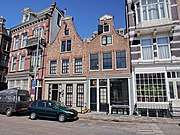Schippersgracht
The Schippersgracht is a canal and street in the Centrum district of Amsterdam that runs from the Rapenburgerplein to the Prins Hendrikkade .
Schippersgracht with the Scharrebier lock | |
 | |
| Length | 100 metres (330 ft) |
|---|---|
| Location | Amsterdam |
| Postal code | 1016 |
| Coordinates | 52.370643°N 4.912141°E |
| East end | Rapenburgerplein |
| To | Prins Hendrikkade |
Location
The Schippersgracht street starts where Foeliedwarsstraat crosses Rapenburgerplein and ends at the Kortjewantsbrug (bridge 487) on Prins Hendrikkade. The Schippersgracht canal is an extension of the Nieuwe Herengracht leading to Nieuwe Vaart, and is about 100 metres (330 ft) long. The quay along the north-west side of the water has the house numbers 2 to 16, with even and odd numbers alternating (not opposite each other). In the past there were higher house numbers, up to 423. The current numbering began in the 19th century. The southeastern bank of the canal is called Kadijksplein. The Schippersgracht owes its name to the fact that many skippers lived here.
Architecture
There are a number of monumental buildings from the 17th century on Schippersgracht, including numbers 14 and 15. The Amsterdam architect Herman Hendrik Baanders (1849–1905) designed Schippersgracht 5 (1897). Baanders was mainly active in Amsterdam.
History
In April 1854 the Amsterdamsche Duinwater-Maatschappij started installation of drinking water on the Schippersgracht. Around 1906 the end of tram line 2 was on the Schippersgracht. This was canceled after six months and shortened to Central Station.
 Schippersgracht, corner with Prins Hendrikkade
Schippersgracht, corner with Prins Hendrikkade Schippersgracht 14-16
Schippersgracht 14-16- Amsterdam Canal Parade 2017
.jpg) Section of the canal
Section of the canal
.jpg)